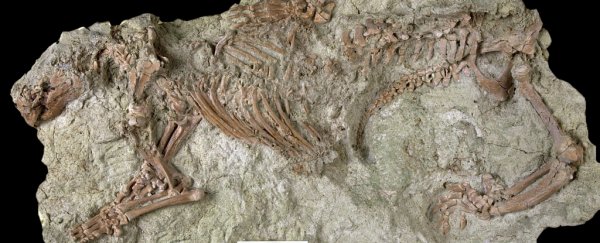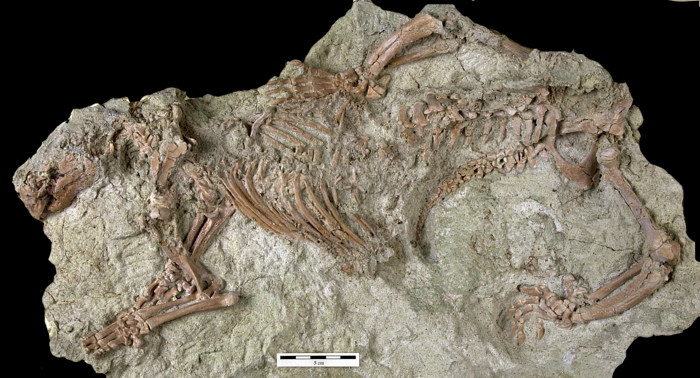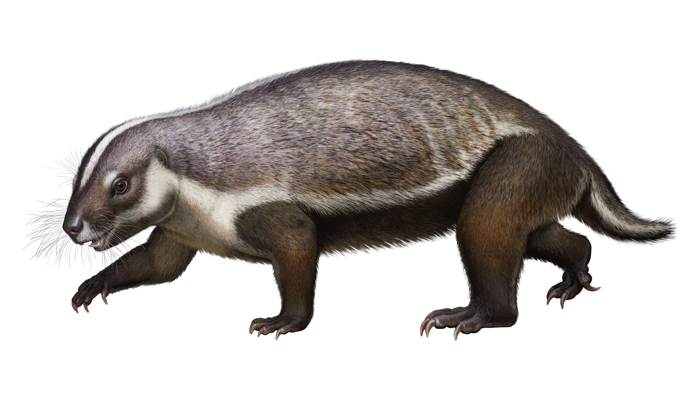It’s not every day that scientists uncover an entirely new species of mammal, let alone a creature whose shrouded origins lie so far back in time, they emanate from the mysterious supercontinent of ancient Gondwana.

In a new study, researchers have unveiled the fossilised remains of a new genus and species discovered in Madagascar. Dubbed Adalatherium hui – the name means ‘crazy beast’. This small, cat-sized critter lived on Earth during the Maastrichtian age of the Late Cretaceous, approximately 72.1–66 million years ago.
That puts A. hui at the tail end of the Mesozoic era, and Mesozoic mammals from the southern hemisphere – a mysterious group of animals known as gondwanatherians – are little understood, owing to a scarcity of identifiable remains in the fossil record.
Before now, the entire clade was known only by a single cranium – also found on Madagascar – in addition to some isolated dental and jaw remains.
That’s what makes this crazy beast such an amazing find, giving us an extremely well-preserved and almost complete skeleton that amounts to the most complete fossil of a Gondwanan Mesozoic mammaliaform ever found, and what might be the oldest mammal ever discovered in the southern hemisphere.

Adalatherium hui. (Marylou Stewart)
“We could never have believed we would find such an extraordinary fossil of this mysterious mammal,” says one of the research team, evolutionary morphologist Alistair Evans from Monash University.
“This is the first real look at a novel experiment in mammal evolution.”
A. hui represents an experiment because of the unusual, isolated circumstances of its evolution. The ancient supercontinent of Gondwana started to break up into pieces about 180 million years ago, eventually leading to Australia, Africa, Antarctica, Madagascar, South America, and India separating.
Amid this epic fragmentation, the Madagascar portion clung to the Indian subcontinent for another 90 million years or so, until it finally broke off approximately 88 million years ago, existing as a remote island ever since.
Given the fact this newly discovered A. hui individual lived on Earth approximately 20 million years later, that means its kind evolved in island-dwelling isolation for tens of millions of years – circumstances that are known to sometimes promote evolutionary oddities, compared to animals that live on the mainland.

Artist’s reconstruction. (Andrey Atuchin)
“Island environments promote evolutionary trajectories among mammals and other vertebrates that contrast with those on continents, and which result in demonstrable anatomical, physiological, and behavioural differences,” the authors write in their study .
“These differences have previously been ascribed to markedly distinct selection regimes that involve factors such as limited resources, reduced interspecific competition, and a paucity of predators and parasites.”
Exactly what factors induced the craziness of the crazy beast isn’t fully clear, but a 20-year-long analysis of the remains (the fossil was first discovered in 1999) indicates it is indeed a strange creature.
“Knowing what we know about the skeletal anatomy of all living and extinct mammals, it is difficult to imagine that a mammal like Adalatherium could have evolved,” says vertebrate palaeontologist David Krause from the Denver Museum of Nature & Science, who helped find the skeleton during a field expedition in Madagascar in 1999.
“It bends and even breaks a lot of rules.”
Part of the weirdness is the primitive septomaxilla bone in its snout region – a feature that disappeared 100 million years earlier in the ancestors of living modern mammals.
It also had more openings (called foramina ) in its cranium than any known mammal, the researchers say, which may have enhanced the sensitivity of its snout and whiskers, by enabling passage for nerves and blood vessels through the skull.
While this individual is thought to have been immature in terms of its physical development, it nonetheless was very large – with an estimated body mass of 3.1 kg (6.8 lb) – at least for mammals at this time, although that might be attributable to a kind of gigantism found in cases of isolated evolution.
The animal had strangely bowed leg bones, too, and researchers aren’t sure whether it used its limbs for digging, or running, or even other kinds of locomotion. Then there are the teeth.





